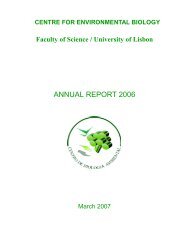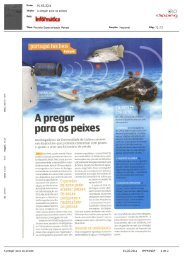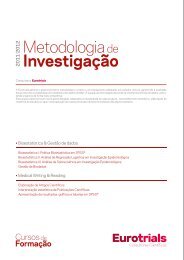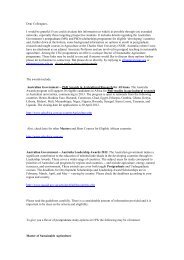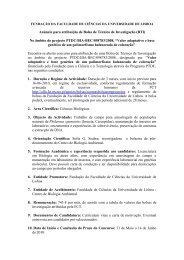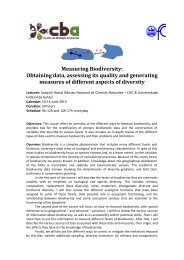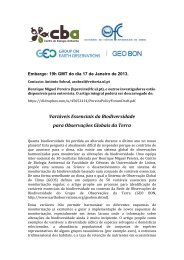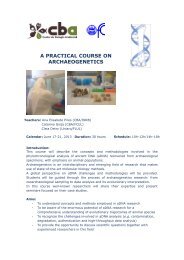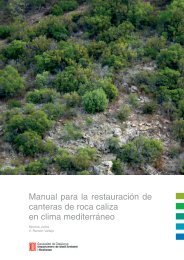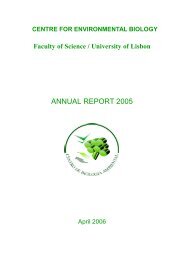European Red List of Vascular Plants - European Commission
European Red List of Vascular Plants - European Commission
European Red List of Vascular Plants - European Commission
Create successful ePaper yourself
Turn your PDF publications into a flip-book with our unique Google optimized e-Paper software.
7. Recommendations<br />
7.1 Overview and recommendations for<br />
conservation measures<br />
This is the first step towards a <strong>European</strong> <strong>Red</strong> <strong>List</strong> <strong>of</strong><br />
<strong>Vascular</strong> <strong>Plants</strong>, providing information on the threat<br />
status <strong>of</strong> 1,826 selected plant species. <strong>Plants</strong> are <strong>of</strong> major<br />
importance to ecosystems and livelihoods supplying<br />
the planet and humankind with essential resources<br />
such as oxygen, food and medicines. Aquatic plants are<br />
fundamental for the functioning <strong>of</strong> freshwater ecosystems.<br />
Crop wild relatives have a critical role in food security<br />
and economic stability, given the growing problem <strong>of</strong><br />
global food insecurity resulting from climate change and<br />
other threats (as well as the global inter-dependence <strong>of</strong><br />
nations in terms <strong>of</strong> food security). In order to improve<br />
the conservation status <strong>of</strong> <strong>European</strong> vascular plants and<br />
to halt the loss <strong>of</strong> diversity, a number <strong>of</strong> conservation<br />
measures are urgently needed. In particular:<br />
Integrate <strong>European</strong> vascular plant conservation actions<br />
and requirements into policy and legislation<br />
■■<br />
■■<br />
■■<br />
Use this <strong>European</strong> <strong>Red</strong> <strong>List</strong> <strong>of</strong> <strong>Vascular</strong> <strong>Plants</strong> when<br />
revising relevant <strong>European</strong>, regional and national<br />
legislation, to improve the conservation status <strong>of</strong><br />
threatened species.<br />
Improve policy measures to reduce the impact <strong>of</strong><br />
habitat degradation, fragmentation and isolation,<br />
in particular related to future urban and tourism<br />
development, and to conserve wildlife habitats<br />
in Europe, especially the Common Agricultural<br />
Policy.<br />
Improve the integration <strong>of</strong> biodiversity and<br />
agrobiodiversity conservation activities to ensure<br />
better knowledge and implementation.<br />
Expand the knowledge base on <strong>European</strong> vascular<br />
plants<br />
■■<br />
■■<br />
■■<br />
Conduct further research on threatened <strong>European</strong><br />
species and ensure the adequate management <strong>of</strong><br />
their habitats to underpin conservation programmes<br />
and identify gaps in conservation actions.<br />
Reassess threatened plant species regularly and<br />
when new information becomes available.<br />
Prioritise fieldwork and data collection for Data<br />
Deficient species to determine whether they are in<br />
need <strong>of</strong> conservation attention.<br />
■■<br />
■■<br />
Establish a co-ordinated system <strong>of</strong> vascular plant<br />
recording and monitoring in every <strong>European</strong><br />
country to improve future priority assessments and<br />
assess the impact <strong>of</strong> conservation measures and<br />
future environmental change.<br />
Undertake research on the potential impacts <strong>of</strong><br />
climate change, which presents a new degree <strong>of</strong><br />
threat, in particular to food security.<br />
Ensure that <strong>European</strong> vascular plants are appropriately<br />
conserved in situ and ex situ<br />
■■<br />
■■<br />
■■<br />
■■<br />
■■<br />
Undertake systematic gap analysis <strong>of</strong> all<br />
threatened and priority species to ensure<br />
adequate in situ and ex situ conservation <strong>of</strong> plant<br />
diversity.<br />
Draw up Species Action (Recovery) Plans to cover<br />
all threatened <strong>European</strong> vascular plant species.<br />
Improve the protection <strong>of</strong> habitats throughout<br />
Europe to include key individual sites and whole<br />
landscapes. In particular, protect and manage<br />
the network <strong>of</strong> Important Plant Areas that have<br />
been identified in <strong>European</strong> countries that are<br />
not all members <strong>of</strong> the EU 27 and integrate<br />
those sites into the Natura 2000 network, as well<br />
as coordinate the establishment <strong>of</strong> a network <strong>of</strong><br />
CWR genetic reserves (where possible based on<br />
existing Natura 2000 sites).<br />
Identify specific geographical and agricultural<br />
areas within which there is a need to maintain<br />
traditional land management practices such as<br />
low intensity grazing.<br />
Develop adequate ex situ conservation as a backup<br />
measure for threatened species by preserving<br />
them in botanic gardens or gene bank collections.<br />
Inter- and intra-specific genetic diversity should<br />
be systematically taken into account. The material<br />
collected should be accessible to plant breeders,<br />
conservationists, researchers and other noncommercial<br />
stakeholders.<br />
Improve capacity-building and awareness<br />
■■<br />
Strengthen the network <strong>of</strong> <strong>European</strong> plant experts by<br />
providing training and improving communication,<br />
including the mobilisation <strong>of</strong> financial resources.<br />
Specialist Groups play a vital role in the plant expert<br />
network.<br />
53



